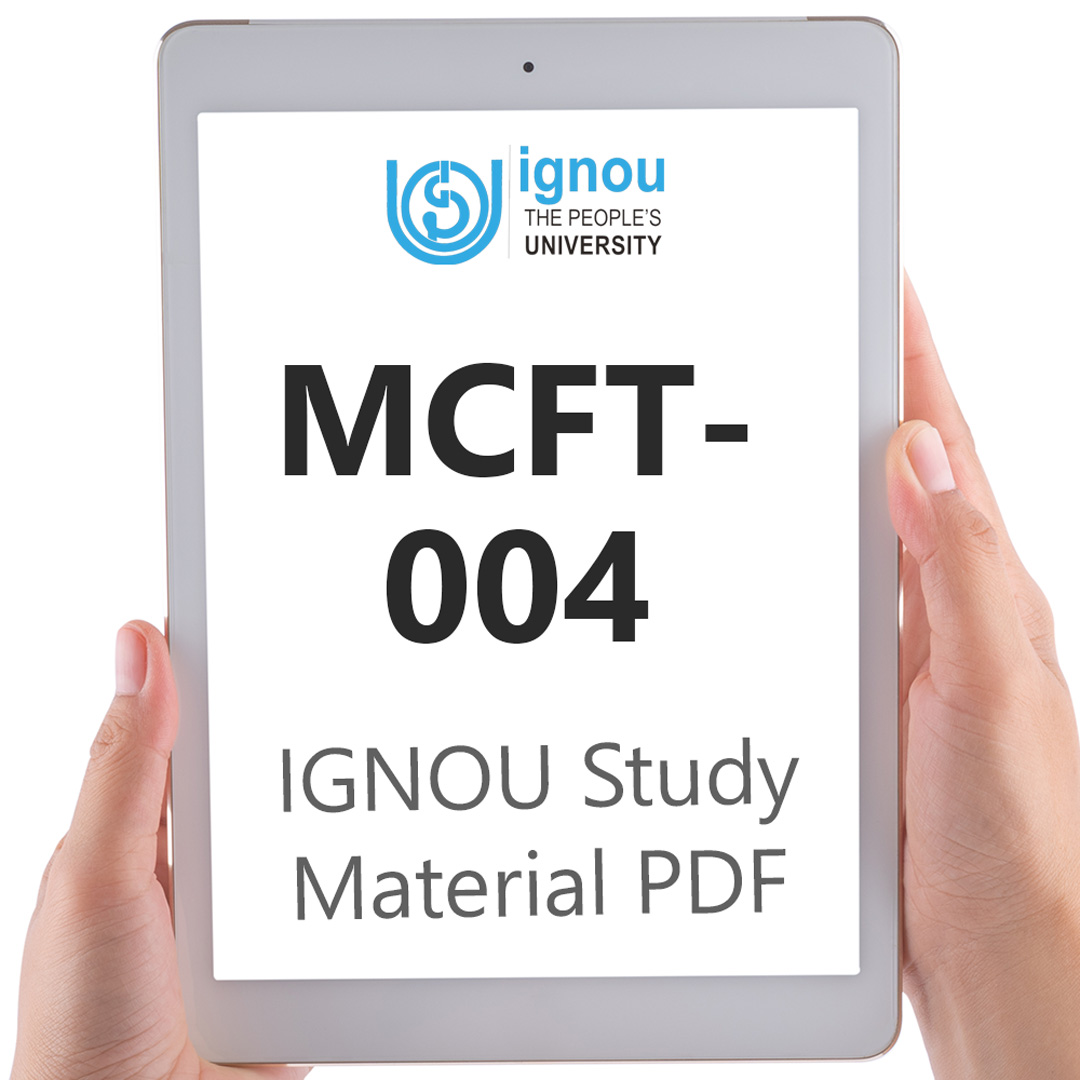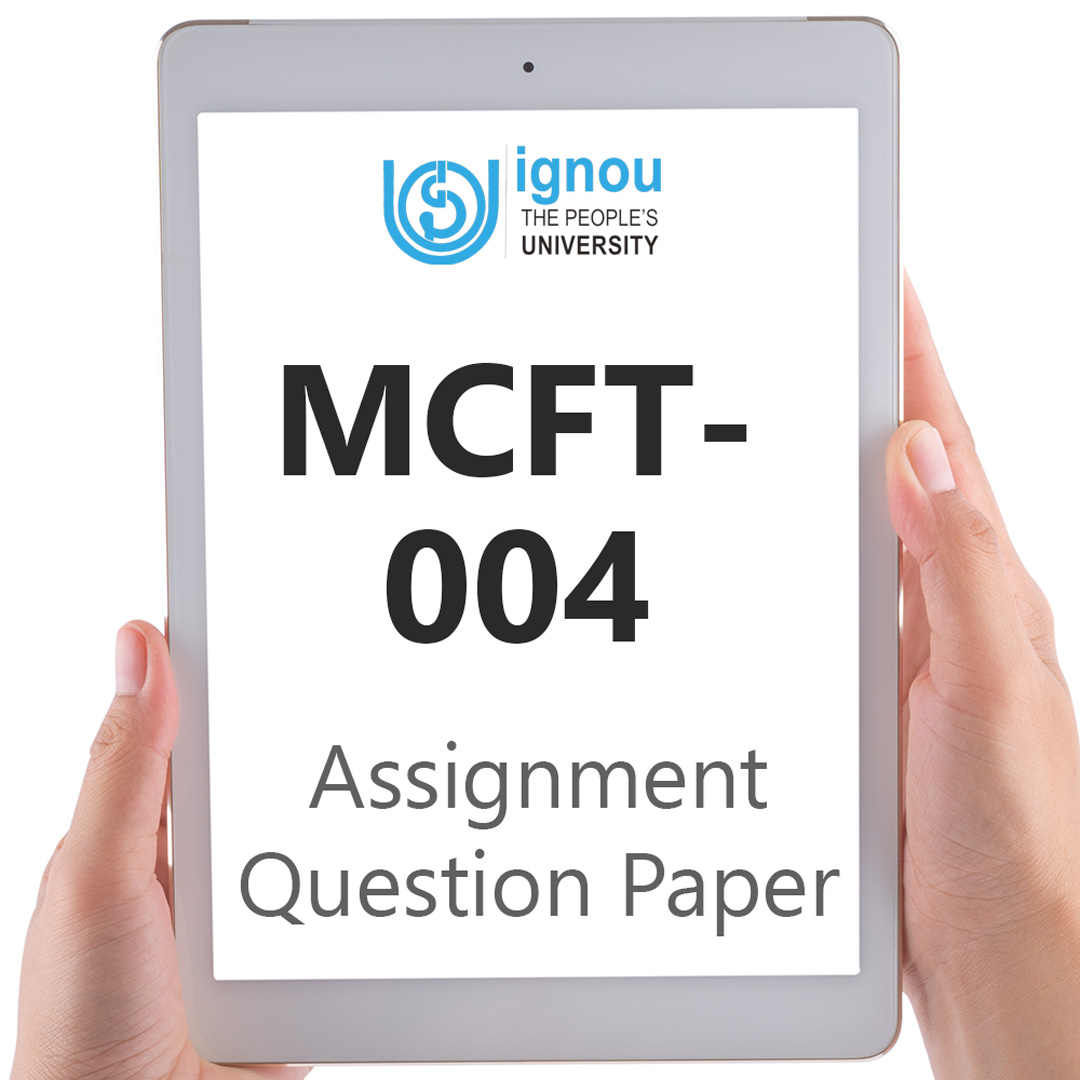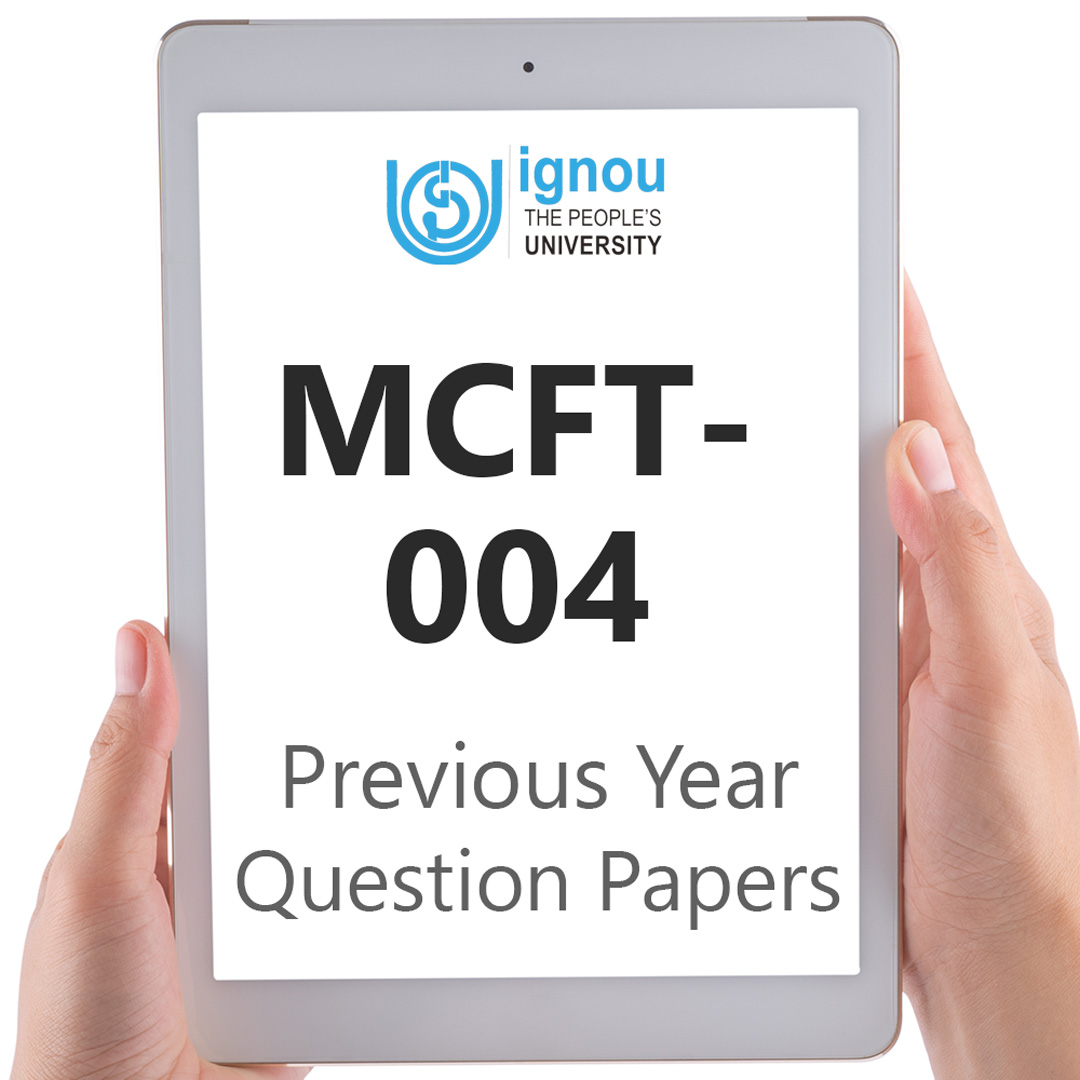If you are looking for MCFT-004 IGNOU Solved Assignment solution for the subject Counselling and Family Therapy: Applied Aspects, you have come to the right place. MCFT-004 solution on this page applies to 2023-24 session students studying in MSCCFT, PGDCFT courses of IGNOU.
MCFT-004 Solved Assignment Solution by Gyaniversity
Assignment Code: MCFT-004/TMA-4/ASST-4/2023-24
Course Code: MCFT-004
Assignment Name: Counselling and Family Therapy : Applied Aspects
Year: 2023-24
Verification Status: Verified by Professor
Note:- (i) Answer all the questions in both sections.
(ii) Answers to questions of Section “A” should not exceed 300 words each.
Section A - Descriptive Questions
Q1) Analyse the common therapist traps.
Ans) Counsellors, psychotherapists, and family therapists may encounter challenges in managing specific interaction patterns during sessions. Donohue et al. (2006) highlight several problematic interactions that therapists should be cautious of, describing them as traps.
The Question Answer Trap:
The therapist asking numerous consecutive questions, limiting the client to short answers.
Solution: Use open-ended questions, encourage clients to elaborate, and employ reflective listening.
The Taking Sides Trap:
The therapist favouring a family member who is more responsive, attends therapy regularly, or expresses themselves openly.
Solution: Avoid taking sides, ask all clients to participate, use open-ended questions with less forthcoming clients.
The Expert Trap:
The therapist providing advice or direction, potentially creating dependence on the therapist's decisions.
Solution: Be a guide rather than giving direct advice, motivate the client's capacity for change.
The Labelling Trap:
The therapist and family members using labels (e.g., addict, warm, unsympathetic).
Solution: Avoid labels, focus on traits that need cultivation or change without demotivating the client.
The Premature Focus Trap:
The therapist quickly focusing on a specific problem, potentially overlooking the client's most pressing concerns.
Solution: Use open-ended questions, gather more information, and reflect on the client's priorities before reaching conclusions.
The Blaming Trap:
The therapist blaming the client for their problems or attributing faults to others.
Solution: Establish a 'No-fault policy,' avoid blaming clients, and work collaboratively to address concerns.
Q2) Discuss the skills involved in ending of session.
Ans) Ending a therapeutic relationship requires specific skills to ensure both client and counsellor satisfaction and provide a proper closure to the therapeutic session.
Asking Appropriate Questions:
Questions should be open-ended, avoiding "why" questions that may appear interrogative. Probing questions encourage clients to expand on their responses, while focusing questions help clarify specific aspects of problems.
Timings of Questions:
Timing is crucial; therapists should refrain from interrupting clients, considering that many clients have waited a long time to be heard. Avoid questioning clients when emotionally overwhelmed.
Giving Information to Clients:
Providing information can be challenging, especially when clients have unrealistic expectations. Counsellors should offer realistic alternatives and suggestions based on clients' strengths.
Recapitulating and Summarizing:
Recapitulating helps tie together disjointed phrases, preserving meaningful dialogues in therapy. Summarizing accurately reflects the client's internal frame of reference, selects important issues, and avoids judgmental statements.
Ending the Session:
Ending sessions skilfully is essential; counsellors can announce the remaining time and collaboratively identify points to discuss in the next session.
Counsellor Self-Disclosure:
Self-disclosure is selectively used, particularly in areas like substance abuse counselling, to encourage clients to persist in overcoming challenges. Counsellors should use self-disclosure judiciously, ensuring correct timing and alignment with the client's best interests. Developing these skills enhances the overall therapeutic process, fostering a positive and respectful conclusion to the counselling relationship.
Q3) Explain, with examples, active communication skills.
Ans) Active communication skills play a crucial role in effective interpersonal interactions. These skills involve not only expressing oneself clearly but also actively listening and responding to others.
Active Listening:
Example: When someone is speaking, maintain eye contact, nod in acknowledgment, and provide verbal cues like "I see" or "Go on" to convey active engagement.
Reflective Responses:
Example: After someone shares their feelings or experiences, respond by reflecting their emotions. For instance, say, "It sounds like you're feeling frustrated about the situation."
Clarification:
Example: If a statement is unclear, ask for clarification. For instance, "Could you please elaborate on what you mean by that?"
Paraphrasing:
Example: Repeat what the other person said in your own words to confirm understanding. For example, "So, if I understand correctly, you're saying that..."
Summarization:
Example: Summarize key points in a conversation to demonstrate comprehension. For instance, "To recap, we've discussed X, Y, and Z. Did I capture that correctly?"
Open-Ended Questions:
Example: Encourage detailed responses by asking questions that require more than a simple yes or no answer. For example, "Can you share more about your experience with that project?"
Empathy:
Example: Acknowledge and validate the other person's feelings. For instance, "It must be challenging to deal with that situation. I understand how you might feel."
Non-Verbal Cues:
Example: Use appropriate facial expressions and body language to convey attentiveness and understanding. Avoiding distractions like checking a phone during a conversation is also crucial.
Avoiding Interrupting:
Example: Allow the speaker to finish expressing their thoughts before responding. This ensures that their message is fully communicated.
Positive Reinforcement:
Example: Provide positive feedback to encourage open communication. For instance, "I appreciate your honesty in sharing your perspective."
Q4) What are life skills? Discuss the need for life skills training.
Ans) Life skills encompass a broad set of abilities that empower individuals to effectively navigate the challenges of daily life, make informed decisions, and handle interpersonal relationships. These skills are not only essential for personal development but also contribute significantly to academic and professional success. Life skills can be categorized into various domains, including personal, social, cognitive, and emotional skills.
Adaptability: Life is unpredictable, and individuals need skills that enable them to adapt to changes and challenges. Life skills foster adaptability, helping individuals navigate transitions and cope with unforeseen circumstances.
Effective Communication: Strong communication skills are essential in personal and professional settings. Life skills training enhances verbal and non-verbal communication, enabling individuals to express themselves clearly, listen actively, and collaborate effectively.
Decision-Making and Problem-Solving: Life is filled with decisions, ranging from simple choices to complex problem-solving scenarios. Life skills training equips individuals with the ability to make informed decisions, analyse situations critically, and solve problems creatively.
Emotional Regulation: Emotional intelligence is a key component of life skills. Training in emotional regulation helps individuals understand and manage their emotions, fostering resilience and positive mental health.
Interpersonal Relationships: Building and maintaining healthy relationships is crucial for personal and professional success. Life skills training focuses on empathy, teamwork, conflict resolution, and assertiveness, enhancing individuals' ability to navigate social dynamics.
Time Management: Productivity and goals require good time management. Life skills training improves time management by teaching prioritisation, goal-setting, and organising.
Stress Management: The demands of modern life can lead to stress and burnout. Life skills training teaches stress management techniques, helping individuals cope with pressure, maintain well-being, and achieve a work-life balance.
Continuous Learning: Lifelong learning is a key component of personal and professional growth. Life skills training instils a mindset of continuous learning, adaptability, and openness to new experiences.
Q5) Discuss the experiential awareness techniques.
Ans) Experiential awareness techniques are approaches that encourage individuals to become fully present and engaged in their immediate experiences, fostering a heightened sense of self-awareness and mindfulness. These techniques draw from experiential therapies, mindfulness practices, and Eastern contemplative traditions. The aim is to help individuals connect with their thoughts, emotions, and sensations in the present moment, promoting self-discovery and personal growth.
Mindfulness Meditation: Mindfulness involves paying non-judgmental attention to the present moment. Meditation practices, such as focused breathing or body scan exercises, help individuals cultivate awareness and observe their thoughts without attachment.
Body Awareness: Techniques like progressive muscle relaxation or mindful body scans direct attention to physical sensations. This promotes a deeper understanding of how stress or emotions manifest in the body.
Guided Imagery: Visualization exercises guide individuals through creating mental images to evoke specific feelings or sensations. This can enhance self-awareness and reveal underlying emotions or concerns.
Expressive Arts Therapy: Engaging in creative expressions such as art, music, or movement allows individuals to explore and communicate their emotions in a non-verbal manner, promoting experiential awareness.
Somatic Experiencing: This approach focuses on the connection between the mind and body. It helps individuals release stored tension and trauma by paying attention to bodily sensations and allowing the body to process unresolved experiences.
Journaling: Writing about thoughts, feelings, and experiences can enhance self-reflection. It encourages individuals to explore their inner world, identify patterns, and gain insights into their emotional landscape.
Breathwork: Conscious breathing exercises, like deep diaphragmatic breathing or rhythmic breathing, can help regulate emotions, reduce stress, and enhance overall awareness of the breath's impact on the body and mind.
Nature Connection: Spending time in nature promotes experiential awareness by encouraging individuals to engage their senses and connect with the environment. Nature walks or ecotherapy activities facilitate a mindful connection with the surroundings.
Q6) What is reassurance? Explain the use of reassurance in relationship building.
Ans) Reassurance is a communication strategy or action aimed at comforting, supporting, or alleviating concerns in others. It involves providing verbal or non-verbal expressions of support, empathy, and encouragement to instil a sense of comfort and security. In relationship building, reassurance plays a crucial role in fostering trust, promoting emotional well-being, and strengthening the bond between individuals.
Building Trust: Reassurance helps build trust by demonstrating reliability, dependability, and a genuine concern for the well-being of the other person. Consistent reassurance creates a foundation of trust that is essential for healthy relationships.
Emotional Support: In times of uncertainty, stress, or challenges, offering reassurance conveys emotional support. It lets the other person know that they are not alone and that their feelings and concerns are acknowledged and valued.
Stress Reduction: Reassurance can be a powerful tool in reducing stress and anxiety. When individuals feel assured and supported, it helps alleviate worries and contributes to a more positive emotional state.
Enhancing Communication: Reassurance is a form of positive communication that enhances understanding between individuals. It involves active listening, empathy, and validating the feelings of the other person, creating a communicative environment built on openness.
Conflict Resolution: In the face of conflicts or disagreements, reassurance can be a bridge to resolution. It involves acknowledging the concerns of both parties, expressing understanding, and working collaboratively to find solutions.
Promoting Self-Esteem: Reassurance contributes to the development of positive self-esteem by affirming the worth and capabilities of individuals. It helps counter negative self-perceptions and fosters a more positive self-image.
Cultivating Connection: Reassurance is a key element in creating and maintaining a strong emotional connection. It reinforces the idea that individuals can rely on each other for support and understanding, fostering a sense of togetherness.
Section B - Short Answer Type Questions
Q1) Write short notes (in about 150 words each) on the following:
Q1. i) Empty chair technique
Ans) The Empty Chair Technique is a therapeutic intervention commonly used in Gestalt therapy to explore unresolved feelings, conflicts, or unspoken emotions. In this technique, an empty chair represents a person or a significant element in the individual's life, allowing the person to express thoughts and emotions directly to that representation. The person may alternate between chairs, taking on different roles or perspectives to gain insights into internal conflicts or unaddressed issues.
For example, a person might speak to a family member, a part of themselves, or a situation causing distress. This method facilitates self-awareness, emotional expression, and can lead to a deeper understanding of one's feelings and experiences. The therapist guides the process, encouraging the person to engage in a meaningful dialogue with the symbolic representation in the empty chair, promoting introspection and resolution of unresolved emotions.
Q1. ii) Communication to be avoided in a counselling session
Ans) In a counselling session, certain types of communication should be avoided to maintain a safe and therapeutic environment. One crucial aspect is avoiding judgmental or critical language that may make the client feel criticized or invalidated. Counsellors should refrain from imposing personal values or beliefs on clients, ensuring that the session remains client cantered. Inappropriate self-disclosure by the counsellor, sharing personal issues that are not relevant to the client's concerns, should also be avoided to maintain professional boundaries.
Additionally, interrupting or speaking over the client can hinder the therapeutic process, as it may convey a lack of genuine listening and understanding. Using jargon or overly technical language that the client may not comprehend is discouraged, as it may create barriers to effective communication. Finally, making assumptions or premature interpretations without sufficient information can lead to misunderstandings.
Q1. iii) Imagery
Ans) Imagery refers to the use of vivid and descriptive mental pictures or sensory experiences in the mind. It plays a significant role in various psychological and therapeutic practices. In the realm of mental health, guided imagery is a technique where individuals are guided to create detailed mental images to promote relaxation, reduce stress, and enhance overall well-being.
During guided imagery sessions, individuals might be prompted to visualize serene landscapes, positive scenarios, or empowering metaphors. This process engages the mind and body, influencing emotions and perceptions. Imagery can be employed in therapies such as guided visualization, mindfulness, and cognitive-behavioural therapy to address issues like anxiety, pain management, and trauma.
Images tap into the brain's ability to connect thoughts and emotions, promoting a holistic approach to mental and emotional health. Whether employed for relaxation or therapy, visualisation can access and influence the subconscious.
Q1. iv) Steps involved in problem solving
Ans) Problem-solving is a systematic process that involves several steps to identify, analyse, and develop solutions for challenges or issues.
The steps typically include:
Identification of the Problem: Clearly define and understand the problem at hand. This step involves recognizing the discrepancy between the current situation and the desired state.
Analysis of the Problem: Break down the problem into its components and understand the factors contributing to it. This step involves gathering information, examining relationships, and identifying patterns.
Generation of Possible Solutions: Brainstorm and create a list of potential solutions. Encourage creativity and consider various alternatives to address the problem.
Evaluation of Solutions: Assess the pros and cons of each solution. Consider the feasibility, effectiveness, and potential consequences of implementing each option.
Decision-Making: Choose the most appropriate solution based on the evaluation. This step involves making a conscious and informed decision about which course of action to pursue.
Q1. v) Dangers of inadequate structuring
Ans) Inadequate structuring poses several dangers, particularly in contexts such as project management, communication, and organizational planning. Firstly, it can lead to confusion and ambiguity, as unclear structures make it difficult for individuals to understand their roles, responsibilities, and the overall objectives. This lack of clarity may result in miscommunication, decreased productivity, and the inability to meet deadlines.
Secondly, inadequate structuring can hinder efficient decision-making processes. Without a well-defined structure, decision-makers may struggle to access relevant information and involve the appropriate stakeholders, leading to delays or suboptimal choices. Insufficient structuring can also reduce accountability and transparency. Without clear roles and duties, it's hard to hold people or teams accountable for their actions or performance, which can cause conflicts and inhibit collaboration.
Finally, poor project or organisation structure might hinder progress. A strong structure allows for growth and adaptability, while a poor or nonexistent structure may cause chaos and incapacity to handle complexity.
Q1. vi) Counter-transference
Ans) Countertransference refers to a therapist's emotional or psychological response to a client, often reflecting the therapist's unresolved issues or emotions. It involves the therapist projecting their feelings, attitudes, or unresolved conflicts onto the client. This phenomenon can occur unconsciously and may impact the therapeutic relationship and the quality of care provided.
For example, if a therapist has unresolved issues related to an experience, they might react strongly to a client who mentions a similar topic. This emotional response can interfere with the therapist's ability to remain objective and provide unbiased support.
Recognizing and managing countertransference is crucial for therapists to maintain professionalism and offer effective treatment. Supervision, self-reflection, and ongoing training are essential tools for therapists to address and mitigate countertransference issues, ensuring that the therapeutic process remains focused on the client's needs rather than the therapist's unresolved emotions or experiences.
Q1. vii) Progressive relaxation training
Ans) Progressive Relaxation Training (PRT) is a stress management technique that involves systematically tensing and then relaxing different muscle groups in the body to induce a state of physical and mental relaxation. Developed by physician Edmund Jacobson in the early 20th century, PRT aims to reduce muscle tension, anxiety, and overall stress levels.
During a PRT session, individuals typically start by focusing on a specific muscle group, tensing those muscles for a few seconds, and then gradually releasing the tension while paying attention to the sensations of relaxation. The process is repeated for various muscle groups, moving from head to toe.
PRT helps people become more aware of physiological sensations and relax down. It is used in stress management, psychotherapy, and self-help. Regular PRT improves sleep, anxiety, and well-being. It is a simple yet powerful way for people to actively manage stress and relax.
Q1. viii) Family hypothesis
Ans) In the field of family therapy, the term "family hypothesis" refers to a notion in which the therapist works to formulate hypotheses regarding the underlying dynamics, patterns, and interactions that occur inside a family system itself. The process entails the investigation and identification of potential elements that are influencing the problems and difficulties that the family is experiencing.
These hypotheses are developed by therapists on the basis of observations, information acquired from members of the family, and an understanding of the dynamics embedded within the system. One of the objectives is to develop a functional framework that will assist in directing the treatment process. Possible topics of investigation for family hypotheses include patterns of communication, power dynamics, unsolved conflicts, and other elements that have an effect on the functioning of the family.





